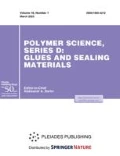Abstract
Industrial production of portland cement with the simultaneous introduction of hydrophobic components is simulated. Their effect on the properties of the modified portland cement is determined. The method developed provides insulation of the cement from drip and, partially, vaporous moisture. The interaction between the dispersed phase of the cement and molecules of the organic admixture takes place by forming hydrogen bonds between surface silanol groups of cement particles and oxygen-containing groups of the admixture. The industrial applicability of the hydrophobization method is shown.
Similar content being viewed by others
References
O. S. Misnikov, “Physicochemical basis of hydrophobization of mineral binding materials with additives from peat raw materials,” Teor. Osnovy Khim. Tekhnol. 40(4), 455–464 (2006).
O. S. Misnikov, “Modification of building materials with peat-based additives,” Vse Materialy. Entsiklop. Sprav., No. 6, 20–26 (2007).
Physicochemical Fundamentals of Peat Production Technology, Ed. by I. I. Lishtvan, A. A. Terent’ev, E. T. Bazin, and A. A. Golovach (Nauka i tekhnika, Minsk, 1983) [in Russian].
O. S. Misnikov, A. E. Timofeev, and E. Yu. Chertkova, “Hydrophobization of mineral dispersed materials with peat-based additives,” Trudy INSTORFA, No. 2 (55), 15–33 (2010).
M. I. Khigerovich and V. E. Baier, Hydrophobic Plasticizing Additives for Cements, Mortars, and Concretes (Stroiizdat, Moscow, 1979) [in Russian].
A. A. Pashchenko, M. G. Voronkov, L. A. Mikhailenko, V. Ya. Kruglitskaya, and E. A. Laskaya, Hydrophobization (Naukova Dumka, Kiev, 1973) [in Russian].
B. D. Summ and Yu. V. Goryunov, Physicochemical Basis of Wetting and Spreading (Khimiya, Moscow, 1976).
E. D. Shchukin, A. V. Pertsov, and E. A. Amelina, Colloid Chemistry, Moscow: Vysshaya Shkola, 1992.
B. V. Deryagin, N. V. Churaev, and V. M. Muller, Surface Forces (Nauka, Moscow, 1985).
Author information
Authors and Affiliations
Corresponding author
Additional information
Original Russian Text © O.S. Misnikov, 2013, published in Vse Materialy. Entsiklopedicheskii Spravochnik, 2013, No. 8, pp. 35–43.
Rights and permissions
About this article
Cite this article
Misnikov, O.S. A study of the properties of portland cement modified using peat-based hydrophobic admixtures. Polym. Sci. Ser. D 7, 252–259 (2014). https://doi.org/10.1134/S1995421214030149
Received:
Published:
Issue Date:
DOI: https://doi.org/10.1134/S1995421214030149




